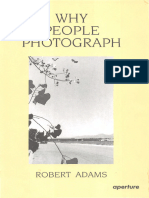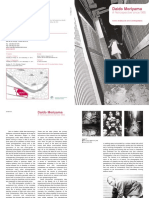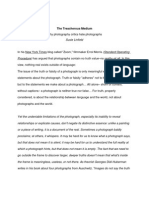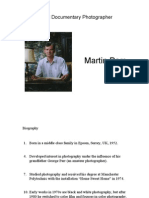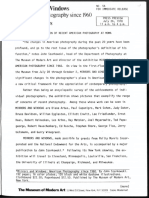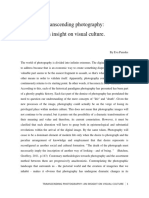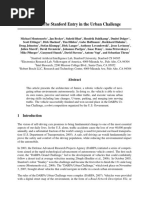Walker Evans
Walker Evans
Uploaded by
lcahill17Copyright:
Available Formats
Walker Evans
Walker Evans
Uploaded by
lcahill17Copyright
Available Formats
Share this document
Did you find this document useful?
Is this content inappropriate?
Copyright:
Available Formats
Walker Evans
Walker Evans
Uploaded by
lcahill17Copyright:
Available Formats
Stare, pry, listen, eavesdrop. Die knowing something. You are not here long.
Walker Evans By: Lauren Cahill
Born November 3, 1903 Died April 10, 1975 Spent most of his young life in Toledo, Chicago, and New York City. Evans discovered literature and first had the idea to become a writer.
Self portrait of Walker Evans.
Fortune magazine. He became the editor of Fortune magazine. Let Us Now Praise Famous Men Pictures taken during the Great Depression were published.
This picture was taken during the Great Depression. Taken in Alabama (1936) The show depression, and has good tonal contrast.
Evans spent two months on a fixedterm photographic experiment for the Resettlement Administration.
In this photo Evans shows the feeling of these kids being tired after working on a hot day. Rule of Thirds, and shallow depth of field, negative space, tonal contrast.
The Resettlement Administration hired photographers to document the living and working conditions of America during The Depression.
This picture uses the rule of odds, tonal contrast, and rule of thirds.
Was influenced by the French photographer Eugne Atget. Also was impressed by another Frenchman Henri CartierBresson.
This picture was taken by Henri Cartier-Bresson using the golden spiral.
Evans inspired Helen Levitt, Robert Frank, Diane Arbus, and Hilla Becher to become photographers.
This photo was taken by Robert Frank using one of Evans techniques.
Evans recorded the many problems of the Administration during the Depression from 1935-1938.
This photo would have been much better if there werent someone in the background. Because it makes it sort of unbalanced.
Evans photos gave visual images to help capture some of the many difficulties of The Great Depression.
Hoping for a ride to a better place. Rule of thirds.
Instead of portraits and photos of beauty and wealth, he documented history and showed the other side.
Rule of thirds and good tonal contrast.
The ability to document history through simple photos was Walker Evans style.
A typical hard working day for the prisoners. Rule of odds.
Images of everyday places.
Documented living conditions.
His photos help capture how hard times really were. Rule of thirds, and rule of odds and tonal contrast.
His portraits one of showed faces of despair.
This picture was taken in Alabama of a hard working family. Good Tonal contrast.
Wales, Jimmy. Walker Evans . 16 Mar. 2013. Web. 18
Mar. 2013.
McKendry, John . Walker Evans (1903-1975). Oct. 2004. Web. 11 Mar. 2013. Colberg, Joerg. Walker Evans - Decade by Decade. 19 Feb. 2010. Web. 13 Mar. 2013. Nelson, Cary. A Photo Essay on the Great Depression. . Web. 12 Mar. 2013.
Chikvaidze, Nutsa. Walker Evans. Web. 14 Mar. 2013.
Gerber, Louis. Walker Evans Biography and Exhibition. 8 July 2000. Web. 14 Mar. 2013. Barr, Nancy. Photography. 27 Feb. 2010. Web. 15 Mar. 2013. Paul Getty. Walker Evans . Web. 12 Mar. 2013. Kershaw, Daniel. The Metropolitan Museum of Art. 25 Feb. 2000. Web. 11 Mar. 2013.
Documentary photography has nothing whatsoever to do with art. But it is art for all that. Walker Evans
You might also like
- Mock Board Exam On Nutritional Biochemistry and Clinical Dietetics1Document25 pagesMock Board Exam On Nutritional Biochemistry and Clinical Dietetics1JermeLou Bao100% (16)
- Why People Photograph Selected Essays and Reviews (Robert Adams) (Z-Library)Document196 pagesWhy People Photograph Selected Essays and Reviews (Robert Adams) (Z-Library)JuJutsuNo ratings yet
- All About Saul LeiterDocument9 pagesAll About Saul LeiterДмитрий Жеребятьев0% (1)
- Eugene AtgetDocument17 pagesEugene Atgetgonzalo1967100% (1)
- Daido Moriyama - A Retrospective Since 1965Document2 pagesDaido Moriyama - A Retrospective Since 1965mozkartNo ratings yet
- Extended Perception Through Photography and Suggestion by Minor WhiteDocument13 pagesExtended Perception Through Photography and Suggestion by Minor WhiteStuart OringNo ratings yet
- Wolfgang Tillmans - NoticeDocument74 pagesWolfgang Tillmans - NoticeSusana Vilas-BoasNo ratings yet
- JEFF WALL Frames of ReferenceDocument11 pagesJEFF WALL Frames of ReferenceEsteban PulidoNo ratings yet
- Joel Meyerowitz FinalDocument5 pagesJoel Meyerowitz Finalapi-285595577No ratings yet
- Pinhole of NatureDocument83 pagesPinhole of Naturebenhofmann100% (1)
- Ricoh GR Ebook GuideDocument57 pagesRicoh GR Ebook Guideseifadiaz100% (1)
- Szarkowski - The Photographers EyeDocument9 pagesSzarkowski - The Photographers Eyeapi-35620112No ratings yet
- WSM PG145 Eu CatDocument124 pagesWSM PG145 Eu Catalkhumini100% (2)
- CONTEC8000S英文正文140430Document60 pagesCONTEC8000S英文正文140430Lucy Fernanda MillanNo ratings yet
- Presentation Sebastião SalgadoDocument14 pagesPresentation Sebastião SalgadoGrasiele SantosNo ratings yet
- Todd Hido 406Document11 pagesTodd Hido 406Luca RosacutaNo ratings yet
- Looking For Walker EvansDocument5 pagesLooking For Walker EvansdaddypanamaNo ratings yet
- William Eggleston - The Life and WorksDocument9 pagesWilliam Eggleston - The Life and Worksapi-356541788No ratings yet
- Gypsy QueenDocument4 pagesGypsy QueendaddypanamaNo ratings yet
- 1 - Stephen Shore Photography PrezDocument22 pages1 - Stephen Shore Photography Prezapi-705544006No ratings yet
- Bourdieu P. Photography - A Middle-Brow Art - 73-98Document16 pagesBourdieu P. Photography - A Middle-Brow Art - 73-98Богдан ТушевскийNo ratings yet
- Garry WinograndDocument9 pagesGarry Winograndapi-299762873No ratings yet
- The Photographic Idea Lucy SouterDocument12 pagesThe Photographic Idea Lucy SouterBezdomniiNo ratings yet
- ElliottErwitt PPTDocument11 pagesElliottErwitt PPTRocío Gutiérrez de CabiedesNo ratings yet
- Street Photography Ethics (Photography Degree, Year 2, Essay 1)Document8 pagesStreet Photography Ethics (Photography Degree, Year 2, Essay 1)Dan FoyNo ratings yet
- Linfield - Why Photo Critics Hate PhotographyDocument25 pagesLinfield - Why Photo Critics Hate PhotographypiibemannNo ratings yet
- Approaching Invisibility Experiencing The Photographs and Writings of Minor White Paul Sutton PDFDocument12 pagesApproaching Invisibility Experiencing The Photographs and Writings of Minor White Paul Sutton PDFferlacerdaNo ratings yet
- Photography Theory: A Bluffer's GuideDocument9 pagesPhotography Theory: A Bluffer's Guidexmanws8421No ratings yet
- Manuel Alvarez Bravo - Pasadena Art Museum CatalogDocument65 pagesManuel Alvarez Bravo - Pasadena Art Museum CatalogGiovanni BelloNo ratings yet
- Photographies: Please Scroll Down For ArticleDocument23 pagesPhotographies: Please Scroll Down For ArticleCamila Leite de Araujo100% (1)
- Seventh Documentary Education KitDocument15 pagesSeventh Documentary Education KitVinit GuptaNo ratings yet
- Candida HoferDocument15 pagesCandida Hoferapi-531028249No ratings yet
- Street PhotographyDocument14 pagesStreet PhotographyNicolas ANo ratings yet
- All Photographers1Document71 pagesAll Photographers1api-244578825No ratings yet
- 6 Great PhotoDocument20 pages6 Great Photoalison_fungNo ratings yet
- Frederick Sommer - An Exhibition of PhotographsDocument32 pagesFrederick Sommer - An Exhibition of PhotographsStuart Oring100% (1)
- Henri Cartier BressonDocument7 pagesHenri Cartier Bressonmarjaaaaa50% (2)
- Robert AdamsDocument10 pagesRobert Adamseli brandt100% (1)
- Photography and Cinematic Surface: EssayDocument5 pagesPhotography and Cinematic Surface: EssayVinit GuptaNo ratings yet
- No Blueprint: Text by Robert Goethals, Photography by Robert HeineckenDocument7 pagesNo Blueprint: Text by Robert Goethals, Photography by Robert Heineckendaddypanama100% (1)
- Martin Parr PowerPoint Part 1Document13 pagesMartin Parr PowerPoint Part 1api-3754926No ratings yet
- Compare and Contrast Contemporary and Historical PhotographersDocument3 pagesCompare and Contrast Contemporary and Historical PhotographersmsuthsNo ratings yet
- Penn Irving BibliografiaDocument133 pagesPenn Irving BibliografiaPaolo Bianchi100% (1)
- Dorothea Lange (Photography Art Ebook)Document137 pagesDorothea Lange (Photography Art Ebook)Robert Marin100% (1)
- Mirrors and WindowsDocument4 pagesMirrors and WindowspaNo ratings yet
- Nature of Photographs Interview PDFDocument11 pagesNature of Photographs Interview PDFreadalotbutnowisdomyetNo ratings yet
- Ernst Haas - Master PhotographerDocument10 pagesErnst Haas - Master PhotographerBC Edwards100% (1)
- From MemoryDocument4 pagesFrom MemoryAngus CarlyleNo ratings yet
- Moma Catalogue 2347 300062558Document159 pagesMoma Catalogue 2347 300062558otilia_alexandru_1100% (1)
- Koudelka Josef BibliografiaDocument88 pagesKoudelka Josef BibliografiaHenry TakesNo ratings yet
- Robert FrankDocument7 pagesRobert FranknickconstantNo ratings yet
- Aperture Guide 2018 FINAL PDFDocument49 pagesAperture Guide 2018 FINAL PDFMárcio Guerra0% (1)
- The Death of PhotographyDocument9 pagesThe Death of PhotographyEva del RealNo ratings yet
- Martin Parr, Wassink Lundgren, Gu Zheng, Raymond Lum, Stephanie H. Tung, Gerry Badger - The Chinese Photobook - From The 1900s To The Present-Aperture (2015)Document225 pagesMartin Parr, Wassink Lundgren, Gu Zheng, Raymond Lum, Stephanie H. Tung, Gerry Badger - The Chinese Photobook - From The 1900s To The Present-Aperture (2015)Sauradip GhoshNo ratings yet
- Ricoh GRD IV Ebook GuideDocument23 pagesRicoh GRD IV Ebook GuidefurrypdfNo ratings yet
- A Method of Documentary Photography and Its ApplicDocument7 pagesA Method of Documentary Photography and Its Applicosbert tingNo ratings yet
- BrassaiDocument1 pageBrassaiCourtney-Jade O'ReillyNo ratings yet
- Saul Leiter DosDocument19 pagesSaul Leiter DosPascual FidelioNo ratings yet
- Photographer's Eye John - SzarkowskiDocument6 pagesPhotographer's Eye John - SzarkowskiJose Gabriel100% (1)
- Avinash SinghDocument16 pagesAvinash Singhproject wordNo ratings yet
- KR-301 ControlDocument16 pagesKR-301 ControlSreekanthMylavarapuNo ratings yet
- Show Program - BDocument8 pagesShow Program - BRumble TheatreNo ratings yet
- BEAL CR12 FROM OCT 2024Document1 pageBEAL CR12 FROM OCT 2024rikii80No ratings yet
- Wholesale Food Warehouse Risk Control Plan WorkbookDocument74 pagesWholesale Food Warehouse Risk Control Plan Workbooknicoleta_grosu87No ratings yet
- Catalytic Chemistry in Industry: PremiseDocument36 pagesCatalytic Chemistry in Industry: Premisejai d gr8No ratings yet
- Xmanager Manual PDFDocument103 pagesXmanager Manual PDFDiego MoraniNo ratings yet
- Tds Paragrid 05 - Rev12 20160830 - enDocument2 pagesTds Paragrid 05 - Rev12 20160830 - enIlie DuncaNo ratings yet
- SEACUT DeliverablesDocument2 pagesSEACUT DeliverablesAr-Reb AquinoNo ratings yet
- Genesis Matrix TradingDocument8 pagesGenesis Matrix TradingKhoa DuyNo ratings yet
- Introduction To Developmental BiologyDocument5 pagesIntroduction To Developmental Biologytanitanwani54No ratings yet
- ACTFL Proficiency GuidelinesDocument8 pagesACTFL Proficiency GuidelinesAndres Eliseo LimaNo ratings yet
- Seohyun & Yonghwa - Banmal SongDocument4 pagesSeohyun & Yonghwa - Banmal SongIngvar Estorco Jr67% (3)
- Life With Operations Research EssayDocument4 pagesLife With Operations Research Essayheskeytime69247No ratings yet
- 01 Learn Ebs Oci Apex Adb Selectai Genai Nlq 3059877.1 Nov-2024 (1)Document38 pages01 Learn Ebs Oci Apex Adb Selectai Genai Nlq 3059877.1 Nov-2024 (1)JohnPalNo ratings yet
- Students WaiverDocument2 pagesStudents Waiverjerickolian.delrosarioNo ratings yet
- Hydrostatic Pressure Test Safety Checklist PDFDocument28 pagesHydrostatic Pressure Test Safety Checklist PDFLukman NulhakiemNo ratings yet
- Updated Question Bank-5Document7 pagesUpdated Question Bank-5Dr. Sushant ShekharNo ratings yet
- 2009 UPLB Annual ReportDocument32 pages2009 UPLB Annual ReportUPLB Office of the Vice Chancellor for Research and ExtensionNo ratings yet
- Definition of SculptureDocument6 pagesDefinition of SculptureErwin Roquid IsagaNo ratings yet
- Substantial Completion CertificateDocument1 pageSubstantial Completion CertificateAnungNugalabNo ratings yet
- Catalog Izama (All Product) - Dec 2023Document13 pagesCatalog Izama (All Product) - Dec 2023Ichsan RalendyNo ratings yet
- Junior: The Stanford Entry in The Urban ChallengeDocument31 pagesJunior: The Stanford Entry in The Urban ChallengeRoger SacchelliNo ratings yet
- Siam Report 39 FinalDocument17 pagesSiam Report 39 Finalsiambangladesh2020No ratings yet
- 7-4 and 7-5 Elastic Collisions: KE KEDocument1 page7-4 and 7-5 Elastic Collisions: KE KEdaminNo ratings yet
- OECD Test Guideline 109 Yoğunluk StandartDocument5 pagesOECD Test Guideline 109 Yoğunluk StandartnilayNo ratings yet
- RetailCo 2 Case AnalysisDocument5 pagesRetailCo 2 Case AnalysisDino De LeonNo ratings yet

